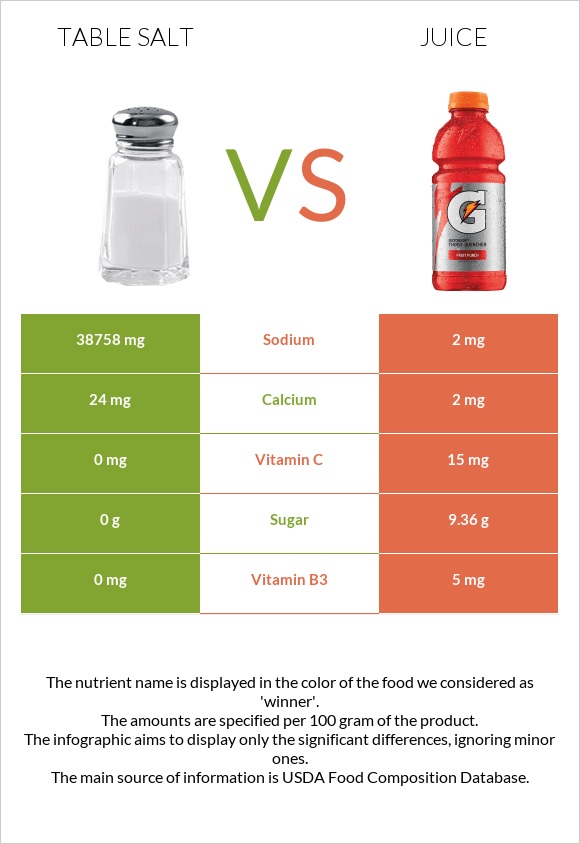Table salt vs. Juice — In-Depth Nutrition Comparison
Compare
What are the differences between table salt and juice?
- Juice is richer than table salt in vitamin B6, vitamin B2, vitamin B1, vitamin B3, and vitamin C.
- Table salt's daily need coverage for sodium is 1685% more.
- Table salt has 12 times more calcium than juice. While table salt has 24mg of calcium, juice has only 2mg.
- The amount of sodium in juice is lower.
- The glycemic index of table salt is lower.
We used Salt, table and Beverages, Orange juice drink types in this article.
Infographic

Infographic link
Mineral Comparison
Mineral comparison score is based on the number of minerals by which one or the other food is richer. The "coverage" charts below show how much of the daily needs can be covered by 300 grams of the food.
| Contains more CalciumCalcium | +1100% |
| Contains more IronIron | +200% |
| Contains more CopperCopper | +66.7% |
| Contains more ZincZinc | +400% |
| Contains more ManganeseManganese | +1328.6% |
| Contains more SeleniumSelenium | +∞% |
| Contains more MagnesiumMagnesium | +200% |
| Contains more PotassiumPotassium | +425% |
| Contains more PhosphorusPhosphorus | +∞% |
| Contains less SodiumSodium | -100% |
Vitamin Comparison
Vitamin comparison score is based on the number of vitamins by which one or the other food is richer. The "coverage" charts below show how much of the daily needs can be covered by 300 grams of the food.
| Contains more Vitamin CVitamin C | +∞% |
| Contains more Vitamin AVitamin A | +∞% |
| Contains more Vitamin EVitamin E | +∞% |
| Contains more Vitamin B1Vitamin B1 | +∞% |
| Contains more Vitamin B2Vitamin B2 | +∞% |
| Contains more Vitamin B3Vitamin B3 | +∞% |
| Contains more Vitamin B5Vitamin B5 | +∞% |
| Contains more Vitamin B6Vitamin B6 | +∞% |
| Contains more FolateFolate | +∞% |
All nutrients comparison - raw data values
| Nutrient |  |
 |
DV% diff. |
| Sodium | 38758mg | 2mg | 1685% |
| Vitamin B6 | 0mg | 0.5mg | 38% |
| Vitamin B2 | 0mg | 0.43mg | 33% |
| Vitamin B1 | 0mg | 0.38mg | 32% |
| Vitamin B3 | 0mg | 5mg | 31% |
| Vitamin C | 0mg | 15mg | 17% |
| Carbs | 0g | 13.41g | 4% |
| Manganese | 0.1mg | 0.007mg | 4% |
| Calories | 0kcal | 54kcal | 3% |
| Iron | 0.33mg | 0.11mg | 3% |
| Calcium | 24mg | 2mg | 2% |
| Potassium | 8mg | 42mg | 1% |
| Fiber | 0g | 0.2g | 1% |
| Copper | 0.03mg | 0.018mg | 1% |
| Zinc | 0.1mg | 0.02mg | 1% |
| Phosphorus | 0mg | 4mg | 1% |
| Vitamin B5 | 0mg | 0.06mg | 1% |
| Folate | 0µg | 4µg | 1% |
| Protein | 0g | 0.2g | 0% |
| Net carbs | 0g | 13.21g | N/A |
| Magnesium | 1mg | 3mg | 0% |
| Sugar | 0g | 9.36g | N/A |
| Vitamin A | 0µg | 2µg | 0% |
| Vitamin E | 0mg | 0.02mg | 0% |
| Selenium | 0.1µg | 0µg | 0% |
| Monounsaturated fat | 0g | 0.01g | 0% |
| Polyunsaturated fat | 0g | 0.01g | 0% |
Macronutrient Comparison
Macronutrient breakdown side-by-side comparison
Protein:
0 g
Fats:
0 g
Carbs:
0 g
Water:
0.2 g
Other:
99.8 g
Protein:
0.2 g
Fats:
0 g
Carbs:
13.41 g
Water:
86.2 g
Other:
0.19 g
| Contains more OtherOther | +52426.3% |
| Contains more ProteinProtein | +∞% |
| Contains more CarbsCarbs | +∞% |
| Contains more WaterWater | +43000% |
~equal in
Fats
~0g





